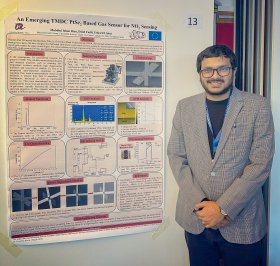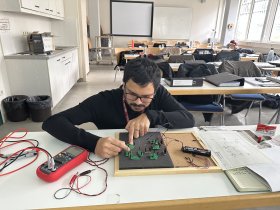Mubdiul Islam Rizu


PhD Programme: Technologies for Nanosystems, Bioengineering and Energy
Research group: MINOS - Microsystems and Nanotechnologies for Chemical Analysis
Supervisor: Eduard Llobet Valero & Dalal Fadil
Bio
Mubdiul Islam Rizu received his BSc degree in Electrical, Electronic and Communication Engineering (EECE) from Military Institute of Science and Technology (MIST), Dhaka, Bangladesh in 2015. He then joined as a Lecturer and served his department for more than two years. Following that, he received Erasmus Mundus Scholarship for his Master Studies in France, Spain and Poland. He obtained his MSc degree in Molecular Nano- and Bio-Photonics for Telecommunications and Biotechnologies from École Normale Supérieure Paris-Saclay, Paris, France in 2019. His master thesis topic was 'Photonic Sensors for Molecular Screening' which took place in the Lyon Institute of Nanotechnology, Lyon, France. Then he moved to Bangladesh and joined as an Assistant Professor in the EECE department of MIST. Mubdiul has published several research papers in IEEE International Conferences. He has immense research interest in Nano-electronic Sensors, Gas Sensors and Biosensors. He is an active member of Erasmus Mundus Association, France Alumni Bangladesh, Marie Curie Alumni Association and MIST Alumni Association. Apart from teaching and research, his hobby is travelling and exploring the unknown. With that thirst, he has travelled more than 30 countries around the world. Mubdiul is now enrolled as a Doctoral Research Fellow at the Departament d'Enginyeria Electrònica, Elèctrica i Automàtica of the Universitat Rovira i Virgili, Spain. Being awarded with MFP-MSCA COFUND Fellowship for PhD, he is currently working on the project 'High Frequency FETs for Gas Sensing'.
Project: Design, Fabrication and Characterization of High Frequency- FET Based Gas Sensor for RF Applications
The project will focus on the characterization from DC to hundreds of GHz of high frequency Field Effect Transistor (HF-FET) of Two Dimensional (2D) nanomaterials and be able to test its performance as microwave gas sensor. This project will support the advance of research for nanotechnology application, achieving highly sensitive and selective miniaturized gas sensors and the integration of sensors in wireless systems. Until now, chemoresistors (i.e. resistive gas sensors) employing metal oxides as gas sensitive films have been the most successfully marketed inexpensive devices. Chemoresistors are simple in layout, easy to operate and can be miniaturized. In addition, metal oxides are highly sensitive to a wide spectrum of gases of interest. Despite all these advantages, they generally require being operated high above room temperature (power-hungry), show poor selectivity and suffer from long-term stability issues. Therefore, metal oxide chemoresistors are not well suited for being integrated into a new generation of 5G enabled IoT devices and unattended gas sensing networks. The development of wireless networks with higher amounts of data transferred at higher speeds is fueling the research in a new generation of high frequency electronics such as high frequency field effect transistors (HF-FETs) employing new nanomaterials. Among the already existing gas sensing platforms, field effect transistors (FETs) are very attractive due to their simple fabrication process, sensitive gas detection and easy miniaturization. Field Effect Transistor gas sensors can become an alternative and superior sensing platform to the current chemoresistors. It can be miniaturized down to the nanoscale and fabricated at low costs employing microsystems technologies. Upon exposure to gas molecules and adsorption of these at the channel area, the electronic structure is altered, which can be exploited for gas sensing. For example, gas adsorption results in the doping of the semiconductor material at the channel, altering the concentration and mobility of charge carriers. Gas adsorption may lead to the formation of dipoles at the surface of the channel, which affects the threshold voltage. Gas detection can be as simple as measuring the change of the drain current after exposing the FET to a target gas under constant drain to source and gate to source voltages. The evolution of FET gas sensors has been closely related to the evolution of nanotechnology and, very particularly to research in two-dimensional (2D) materials.



